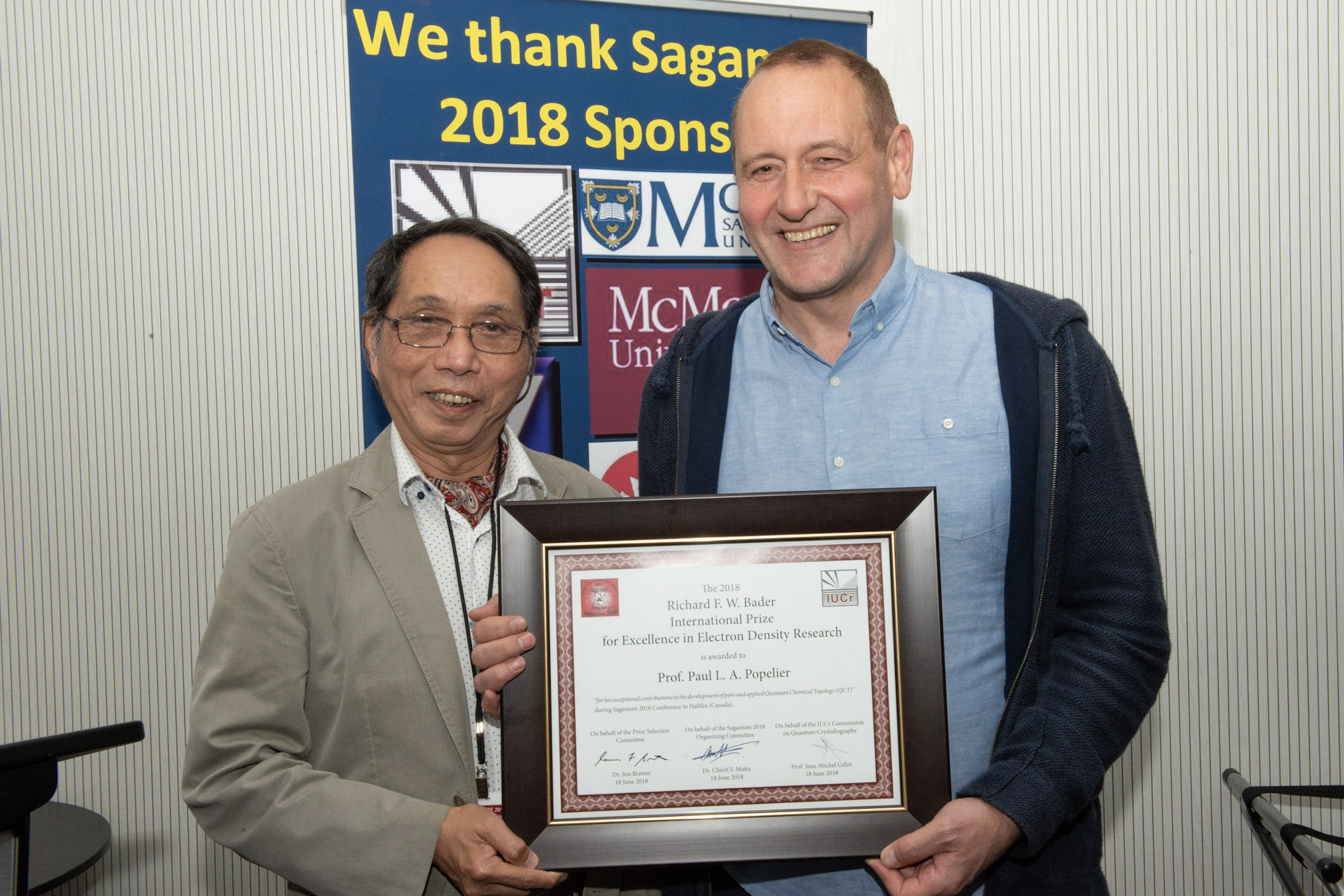
The Richard F. W. Bader International Prize for Excellence in Electron Density Research 2018 (Inaugural) Laureate is
Prof. Paul L. A. Popelier
“for his exceptional contributions in the development of pure and applied Quantum Chemical Topology (QCT)”
SHORT AUTOBIOGRAPHICAL NOTE:
Paul Popelier obtained a PhD at the University of Antwerp(en) in Flanders, Belgium. One of his projects consisted of neutron diffraction experiments on ethyne at Brookhaven National Laboratory, NY, USA. As an undergraduate he had independently discovered that the equation z17 – 1 = 0 can be solved by a nested combination of square roots, which makes the construction of a heptadecagon possible by ruler and compasses. After compulsory military service, and a postdoc with Richard Bader, Popelier secured European funding for a HCM Research Fellowship at the University of Cambridge. He was then appointed as a lecturer (assistant professor) in Manchester at UMIST, which after a merger with the Victoria University became the University of Manchester, where he is currently a Professor of Chemical Theory and Computation and Head of the Comp & Theor Research Section. He holds a DSc and was elected Fellow of the Royal Society of Chemistry. His collection of ~235 publications includes three books and 31 single-author publications, which have been cited more than 4100 times. Eight former members of his research group hold academic positions, in France, Great Britain, Australia, Colombia, Switzerland and China.

———————————————————————————————————————————————
The Inaugural Richard F. W. Bader International Prize for Excellence in Electron Density Research
Call for Nominations
We are pleased to announce the inaugural Richard F. W. Bader Prize to be presented at the Sagamore 2018 Conference.
To celebrate the achievements of Professor Bader, the Richard F. W. Bader International Prize for Excellence in Electron Density Research will be awarded to one established scientist at an advanced stage of their career. The inaugural prize to be awarded in June of 2018 in the Halifax conference and it is hoped that this prize will be awarded as a tradition at subsequent Sagamore conferences.
The Prize:
- A framed Prize Diploma including a short citation explaining the basis upon which the prize has been awarded in relation to the contributions of the winner.
- A 40 minute Award Lecture at the Sagamore Conference.
- A wide announcement to the community via email, social media, newswires and the like. The announcement of the winner is to be made by mid June 2018.
- An “Invited Award Paper” is being negotiated with Physica Scripta, the official physics journal of the Royal Swedish Academy of Science, to highlight the work of the winner(s).
- A financial reimbursement of the registration fee in the form of a cheque payable to the winner while at the conference.
Eligibility:
- This prize is open to any person regardless of national origin, gender, age, etc.
- The nominee should be an “established scientist”, typically at the associate or full professor level (or equivalent), or a senior scientist in government or industry.
- Self-nomination or nomination by others is accepted.
- Topics considered for this award falls under “Quantum Crystallography” broadly defined. Specifically, this include, but not necessarily limited to, experimental and theoretical determination and analysis of the charge, spin, or momentum densities in crystals and/or in isolated molecules, Quantum Chemical Topology, Bader’s Quantum Theory of Atoms in Molecules (QTAIM), experimentally constrained wavefunction or density matrices, etc., with emphasis that could range on fundamental aspects, method development, and/or application.
Nomination Guidelines/Procedures:
- A cover nomination letter of at most 5 pages, explaining the exceptional significance and impact of the nominee’s research in the context of this award. The broad impact, originality, and quality of the work must be clearly described. The cover letter should address both historical (older, long-term) contributions by the nominee and also more their recent contributions.
- A CV of the nominee with a full list of publications.
- Five sample publications that represent the best work by the candidate.
- OPTIONAL: Up to a maximum of two additional letters of support from recognized scientists in the field are recommended but not “required”.
- All the above material should be sent directly under confidential cover to the the Chair of the Richard F. W. Bader International Prize Committee, Professor Jim Britten ([email protected]), preferably as one pdf file of a reasonable (email-able) size.
- It is the responsibility of the nominator to ensure that the whole package including the letters of support are received by the deadline (15 May 2018).
- IMPORTANT NOTE: The main Organizers of Sagamore 2018 (Chérif F. Matta and Paul W. Ayers) are not involved in any way in the nomination, recommendation, selection, or vote regarding this prize – they will not even be informed about the identities of the nominees – and should not be contacted regarding this competition. The Organizers will only make the final announcement when the decision is communicated to them by the Chair of the Selection Committee. All communication about this prize should be with the Chair of the Prize Selection Committee Professor Jim Britten ([email protected]).
The deliberations and individual votes of the committee will remain strictly confidential and its decision cannot be appealed.
Richard Bader Prize Selection Committee:
- James Britten, McMaster University (Canada)
- Kersti Hermansson, Uppsala University (Sweden)
- Todd Keith, SemiChem, Inc. (USA) & TK Gristmill Software (USA)
- Thanh-Tung Nguyen-Dang, Université Laval (Canada)
- John Tse, University of Saskatchewan (Canada)
Richard F. W. Bader (1931-2012). Bader was a Professor of theoretical chemistry at McMaster University. He was a towering figure in quantum chemistry, best known as the originator and primary developer of the Quantum Theory of Atoms in Molecules (QTAIM) and a large part of what came to be known as the broader field of Quantum Chemical Topology (QCT). Bader’s impact upon computational chemistry, crystallography, and materials science was transformative to both applied and fundamental research.
